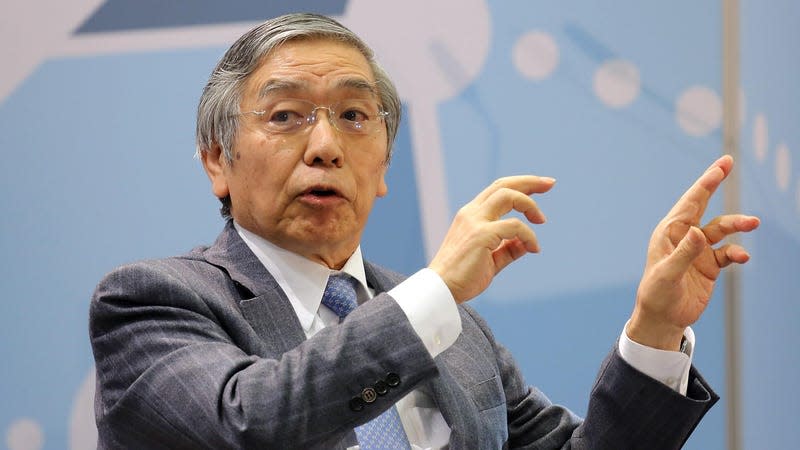Japan could be gearing towards revising its decade-old ultra-loose monetary policy

- Oops!Something went wrong.Please try again later.
The Japanese government looks ready to revise its inflation blueprint. A change at the top of the Bank of Japan (BOJ) could mark the end of a decade-long regime of low interest rates.
In January 2013, then-prime minister Shinzo Abe’s government and the Bank of Japan (BOJ) issued a joint statement (pdf) upping its inflation target from 1% to 2% in an attempt to beat deflation, committing to pursuing “monetary easing” to get there.
Read more
BOJ governor Haruhiko Kuroda, who has helmed the central bank since March 2013, has stuck to this manifesto, pursuing massive monetary stimulus and ultra-low interest rates. Even as major economies like the US and the UK repeatedly hiked rates, Kuroda assured he had “absolutely no plan” to do so. Meanwhile, to reduce the yen’s volatility, Japan has been buying up its own currency.
For the first time in a decade, the policy appears up for reevaluation, as Kyodo News Agency reported on Saturday (Dec.17), citing government sources. The catalyst for the change will be the appointment of a new BOJ governor in April, giving prime minister Fumio Kishida the opportunity to forge a new plan of action for the country’s economy, which has been experiencing unusually high rates of inflation.
According to the Kyodo News Agency report, the government will likely keep a 2% inflation target, while eyeing a more flexible timeline, and promoting wage growth.
Brief history of Japan’s struggle to fight deflation
In the 1980s, the Japanese economy grew rapidly, but it was fueled by stock market and real estate speculation. After the “bubble economy” burst in the early 1990s, the economy came to a near standstill.
During his second term as prime minister, Abe introduced both the 2013 policy of negative interest rates, and also a plan, in 2016, of so-called yield curve control. This meant to keep the yield on ten-year government bonds at “around zero percent”—a strategy to suppress interest rates to keep the cost of borrowing low—as a way to stimulate the economy.
The plan hasn’t quite succeeded. Among the biggest factors playing foul is that Japan has not had any significant real wage growth for almost 20 years, and this isn’t expected to change next year either. “The likelihood of nominal wage growth lagging price rise would heighten the danger of households becoming more frugal, which would affect the economy further,” market research firm GlobalData warns.
Consumer prices have been rising at more than 2% for a few months now. Japan’s inflation rate hit 3.7% in October, clocking a 30-year-high. Experts have chalked this up to surging worldwide gasoline and raw material prices, and rising imports rather than growing demand. Still, it’s reason enough for Kishida’s government to reconsider “Abenomics” as the yen gets weaker and consumer prices keep getting higher.
Charted: The Japanese Yen
Surprise tweak to Japan’s yield control curve
Chief cabinet secretary Hirokazu Matsuno denied the Kyodo News Agency report, telling reporters on Monday (Dec. 19), that the government would not be revising the 2013 statement, as Reuters reported. Yet there’s already been one indication that the dovish central bank is open to some change.
The BOJ decided today (Dec. 20) to allow the 10-year bond yield to move 0.5% on either side of its zero percent target, widening the range from the previous 0.25%. Following the decision, the yen surged and Asian markets sank.
Kuroda said the change aims to enhance the sustainability of Japan’s monetary policy framework and does not signal the end of YCC or an exit strategy—but analysts have interpreted it as a sign of willingness to change.
“It could have been the last chance for the BOJ to move, amid incoming US recession and the end of the Fed’s rate hikes,” said Hiroshi Namioka, chief strategist and fund manager at Tokyo’s T&D Asset Management. “If later, it would have caused a much bigger risk of sharp yen strengthening and other market fluctuations.”
Person of interest: The next BOJ governor
A successor for Kuroda, who does not wish to be reappointed, has not yet been named. For the BOJ’s first change of guard in 10 years, prime minister Kishida will make the nomination and seek approval from both houses of parliament.
The two frontrunners to replace the governor are former deputy central bank governors Masayoshi Amamiya and Hiroshi Nakaso. Nicknamed “MR.BOJ,” Amamiya has consistently called for keeping ultra-low interest rates. Nakaso has been nudging the bank to move away from monetary easing—he’s even written a book about how to do it.
“They are both talented, they both have knowledge of the history of monetary policy, but I don’t think they are the only candidates,” deputy chief cabinet secretary Seiji Kihara said in an interview with Bloomberg News.
Former top financial diplomat Masatsugu Asakawa, Columbia university professor Takatoshi Ito, and former top currency diplomat Takehiko Nakao, have also been floated as possible choices. Like Kuroda, Asakawa and Nakao have both served as the president of the Asian Development Bank.
Related stories
💹 Even Japan is fighting inflation now
💴 This is what it’s costing Japan to deal with the Fed’s rate hikes
🤑 Japan is planning a big hike to its low minimum wages
More from Quartz
Sign up for Quartz's Newsletter. For the latest news, Facebook, Twitter and Instagram.

